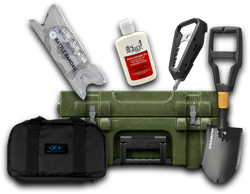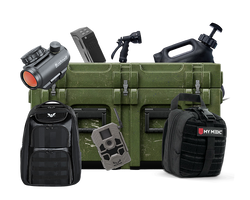
Fishing For Your Life
When SHTF you will run out of packaged food quickly. You will need to rely on your skills to catch fish and hunt game to supplement your stockpile to feed yourself and your family in a dire survival situation. When it comes to fishing for survival, you will need to get creative with passive fishing methods to catch the most fish with the least amount of effort.
If fishing is going to be your main source of protein, you will want to consider not only your location and method of catching fish but also how to keep them alive until you are ready to eat them. If you are going to be remaining in the same location, you can dig a mini “pond” to put the fish into when you catch them. The more fish you catch, the more crowded the pond will get and the more fish you will have available to eat at any given time. Whether you find yourself dealing with wilderness survival or urban survival, knowing these skills and what fishing gear to keep in your survival fishing kit could save your life.
Here are our top five methods recommended for survival fishing techniques:
Fishing Rods. Don’t just make one makeshift rod, make several. Use a strong stick and tie a fishing line, thin string, or piece of paracord to it. Also make sure you have some survival fish hooks stashed away for an emergency situation. Fit the line with a few sinkers and a hook. Bait the hook and drop the line in the water. If you don’t have your survival fishing gear with you (including sinkers and hooks), you will need to get more creative. You can use scrap metal, paper clips, or safety pins to make hooks. A small scrap of aluminum from a soda can works well as a lure to attract fish. You can use worms and insects as bait. Drop as many lines as you can to increase your chances of success. You can push the “poles” into the river bank or tie the lines to trees overhanging the water. This is probably the most widely known survival fishing method.
Trotlines. A trotline is a passive way of catching fish that doesn’t require you to watch the lines all day. Survival fishing this way is not going to be time consuming or tedious, as you will be able to do other things while the trotlines work. You’ll need a narrow point in the river with relatively shallow water. Take a length of paracord and tie it from a branch on one side of the river to a branch on the other. This is called a control line. Then, take sections of multiple fishing lines and tie them to the control line and drop them in the water across the width of the river. The hooks should hang at least a few inches under the surface. Leave your fishing line to catch a few fish as you attend to other survival needs.
Nets. Net fishing is a good way to catch small fish. You can make a net out of greenwood from sapling trees, thin vines, or even pieces of cloth. Wade through the water, dragging the net slowly and calmly behind you. When you get to the other shore, lift the net to see what you have caught.
Spears. Spearfishing takes practice but requires very limited tools. You can make a spear from wood, bone, metal, or hard plastic sharpened at one end. The main challenge with spearfishing is the refraction of light off the water’s surface. It is easiest at night by flashlight when you won’t cast shadows that scare the fish away.
Traps. Fish traps are perhaps the easiest method of passive fishing. Design a container that funnels fish through a small opening into a closed container. The fish will swim into the container and will be unable to find their way back out. An empty plastic water bottle with the cap inverted to create a funnel is a perfect example of a small trap for catching baitfish. For larger fish, you can build a fish weir which is a wall that lures fish into a trap. You can make a weir by stacking rocks to build a wall that covers the length of the river with the exception of an opening that leads to your trap. The water flows smoothly through the screen and fish will follow along the wall until they are trapped.
The most important thing you can do now is practice! Using survival fishing technique with limited supplies is challenging and takes a good bit of practice to master. If you believe yourself to be an expert in these areas, try the backcountry fishing technique of hand fishing, which requires nothing but your own physicality. Find good fishing spots nearby so you will be prepared when it comes time to fish for survival. Always be sure to check the local fishing regulations in the places you practice your survival fishing techniques. Make sure you always have what you need in your survival kit to catch food, whether it be through fishing or hunting. Once you know how to fish, you can almost always find food, which relieves a significant amount of pressure in an emergency.
Share this article







